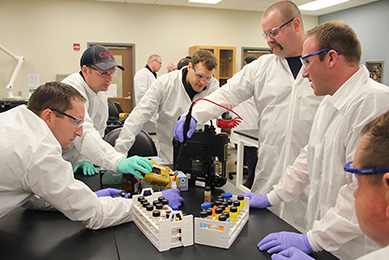
| April 2016 | |||||||||||
| Top stories | |||||||||||
| In the news | |||||||||||
| Photos | |||||||||||
| Contact us | |||||||||||
| Archive | |||||||||||
|
HazMat prepares for chemical threats |
The typical workday for a member of a HazMat team generally does not involve hazardous materials. It’s more likely to include structural and car fires, automobile accidents, and EMS calls. A few times a year, HazMat teams will receive a call from a dispatcher about a chemical release. Sometimes the substance is known. Sometimes it’s not.
 Iowa Hazmat teams practice detecting substances that could be used in a chemical threat.
Iowa Hazmat teams practice detecting substances that could be used in a chemical threat.To help make that determination, 40 HazMat techs from Iowa (Cedar Rapids, Davenport, Fort Dodge, Iowa City and Muscatine) recently came to the Hygienic Laboratory for a hands-on laboratory training about working with these potentially lethal materials.
The one-day course was offered from April 5 – 7, and held in the Hygienic Laboratory’s Center for the Advancement of Laboratory Science. Steve Treimer, environmental laboratory scientist, led the instruction. In addition to his work at the Lab, Treimer is a volunteer firefighter captain and EMT with the Wilton Fire Department/EMS.
In Iowa, the 23 recognized HazMat teams are comprised of career firefighters and, on some teams, volunteer firefighters, too. These responders usually are the first called to the scene of a chemical emergency.
As part of Iowa’s emergency response plan, the Hygienic Laboratory works with HazMat teams to detect and identify chemical agents including cyanide, nerve agents and toxic metals.
The Hygienic Laboratory is one of 44 public health laboratories in the country – including the CDC – that can detect human (referred to as “clinical”) exposure to some chemical threats. These laboratories maintain expertise and capacity, provide rapid toxicology screens, develop testing methods and are part of drills to evaluate their response to emergencies.
The Hygienic Laboratory is the Iowa member on the CDC’s Laboratory Response Network for both biological and chemical threats.
Rigorous course work is required to become a HazMat tech. The training course supplements those requirements with hands-on solvent detection; oxidizer, polymerization, and acid base neutralization demonstrations; and practice detecting “white powders”— a generic term for unknown powder samples that may contain a biological or chemical substance.
The Hygienic Laboratory training began by revisiting the basics of chemistry and working with lethal substances. Treimer led these lectures and the laboratory-based, hands-on training. Dustin May, environmental laboratory supervisor, participated in the course by giving an overview of radiological chemistry as it pertains to first responder emergencies.
“It’s very difficult to give a chemistry review in just a one-hour timeframe,” said Treimer. “The full HazMat Tech course is 80 hours and the HazWoper refresher course is 40 hours. So I chose a couple topics that I wanted to focus on.
“As a volunteer firefighter, I’m often saddened that I’m at work when emergencies occur in my hometown, and I’m not there to help. Doing this type of outreach fills my soul knowing that I’m still a part of the community protecting others.”
The HazMat course is the first to be hosted in the Hygienic Laboratory’s Center for the Advancement of Laboratory Science. Previously, Treimer made similar presentations with Iowa’s 71st Civil Support Team at the WMD (weapons of mass destruction) HazMat locations in Iowa.